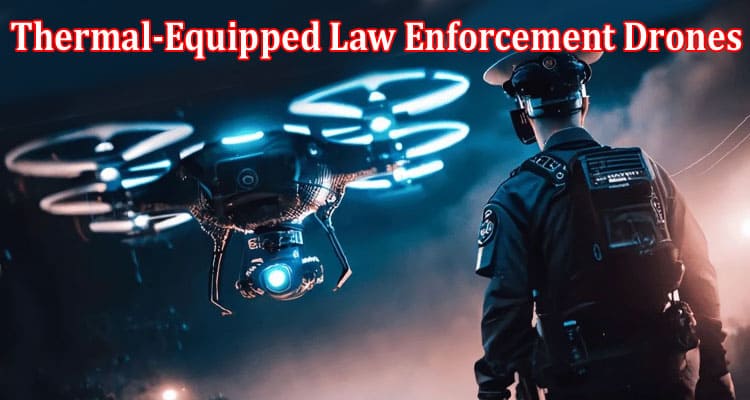Night Operations With Thermal-Equipped Law Enforcement Drones
This article will explore the remarkable advantages and applications of night operations with thermal-equipped law enforcement drones. As law enforcement continues to evolve, police drones equipped with thermal imaging technology have emerged as a powerful asset, enhancing officers’ capabilities and ensuring public safety during nocturnal hours. By harnessing the ability to detect heat signatures and identify persons of interest in low-light conditions, these police drones have revolutionized law enforcement practices, profoundly impacting crime prevention and response.
Enhanced Nighttime Visibility:
One of the most significant advantages of thermal-equipped law enforcement drones is their ability to provide enhanced nighttime visibility. Traditional surveillance methods often struggle to capture clear images and identify individuals in low-light conditions. However, thermal imaging allows drones to detect heat signatures emitted by objects and individuals, irrespective of ambient lighting conditions. This enables law enforcement officers to effectively observe and monitor suspicious activities or locate persons of interest during night operations.
With this technology, law enforcement gains a distinct advantage during nighttime operations, as they can conduct surveillance and identify potential threats more effectively. The ability to detect heat signatures allows officers to distinguish between objects and individuals even in complete darkness, enabling them to respond to incidents promptly and accurately.
Stealthy Surveillance:
Thermal-equipped drones offer law enforcement agencies a stealthy surveillance advantage during nighttime operations. With their quiet operation and discreet flight capabilities, these drones can carry out covert surveillance without alerting potential suspects or causing unnecessary panic in the community. This stealth gives officers a tactical edge, allowing them to observe criminal activities or gather critical intelligence without compromising their position.
By leveraging thermal imaging technology, law enforcement can gather valuable intelligence on criminal activities without revealing their presence. The drones’ silent flight ensures that suspects remain unaware of being under surveillance, increasing the likelihood of apprehending wrongdoers and preventing crimes.
Swift Response to Incidents:
Nighttime incidents often require immediate responses, and thermal-equipped law enforcement drones enable rapid deployment and assessment of the situation. Officers can quickly launch the drone to survey the area, assess threats, and identify potential hazards without harming themselves. This real-time situational awareness empowers law enforcement to make timely and informed decisions during critical nighttime scenarios.
The swift deployment of thermal-equipped drones allows law enforcement to comprehensively understand the situation before taking action. By quickly obtaining visual and thermal data, officers can better assess risks and respond appropriately to emergencies, ensuring the safety of both the public and themselves.
Search and Rescue Operations:
Thermal-equipped drones have proven invaluable assets in search and rescue operations during the night. In cases of missing persons or lost hikers, thermal imaging can aid in locating individuals in dark and challenging terrain. The drones can detect body heat, even in dense foliage or rugged landscapes, allowing search and rescue teams to narrow search areas and improve the chances of finding the missing individuals.
The application of thermal-equipped drones in search and rescue operations enhances the efficiency of these missions. By swiftly identifying heat signatures associated with distressed individuals, search teams can focus on specific areas, increasing the likelihood of successful rescues.
Detecting Illicit Activities:
Thermal-equipped law enforcement drones are pivotal in detecting illicit activities at night. Whether spotting illegal border crossings, identifying drug cultivation sites, or uncovering hidden criminal operations, thermal imaging provides officers with critical insights that may not be visible to the naked eye. The ability to detect heat signatures associated with unlawful activities enhances law enforcement’s ability to combat crime effectively.
Using thermal-equipped drones, law enforcement can effectively identify and target illicit activities. This proactive approach enables officers to address criminal operations swiftly, disrupt criminal networks, and uphold the law more efficiently.
Crowd Monitoring and Event Security:
Large public events held at night can pose significant challenges for law enforcement regarding crowd monitoring and security. Thermal-equipped drones can efficiently monitor crowds, ensuring public safety by detecting unusual or potentially hazardous behavior. These drones assist law enforcement in swiftly identifying and responding to any security threats, maintaining order, and safeguarding attendees during nighttime events.
Using thermal-equipped drones for crowd monitoring enhances public safety and security during events. Spotting anomalies and potential risks in real-time allows law enforcement to respond promptly to any emergent situations, ensuring a safe and enjoyable experience for event-goers.
Preventing Wildlife Crimes:
Nighttime wildlife crimes, such as poaching and illegal hunting, often occur under darkness. Thermal-equipped drones have become indispensable tools in the fight against such crimes. These drones can survey vast areas, detecting the presence of poachers or illegal hunters through thermal imaging. Law enforcement can then coordinate their response to apprehend offenders and protect vulnerable wildlife populations.
Using thermal-equipped drones to prevent wildlife crimes provides a powerful means of conservation and protection. Law enforcement can deter potential offenders, safeguard endangered species, and preserve biodiversity by effectively patrolling wildlife habitats.
Surveillance of Critical Infrastructure:
Protecting critical infrastructure is paramount, and thermal-equipped drones contribute significantly during night operations. Drones can conduct surveillance of power plants, oil refineries, and other critical facilities, detecting potential intruders or security breaches in real time. This proactive approach ensures the timely response and mitigation of any security threats, preventing potential damage to essential infrastructure.
Thermal-equipped drones play a crucial role in maintaining the security of critical infrastructure. Law enforcement can mitigate risks and protect vital facilities from threats by providing continuous surveillance and early detection of security breaches.
Monitoring Suspected Drug Activities:
Using thermal-equipped drones is a game-changer in monitoring suspected drug activities during night operations. These drones can identify heat signatures associated with indoor marijuana grow houses or illegal drug labs, helping law enforcement target and dismantle such operations. The ability to locate these activities from the air allows for safer and more effective drug enforcement efforts.
By employing thermal-equipped drones to monitor drug activities, law enforcement can disrupt drug trafficking networks, seize illegal substances, and enhance public safety. The drones’ ability to see through walls and detect heat signatures associated with drug production facilities provides officers with critical intelligence, aiding them in executing targeted operations against drug-related crimes.
Conclusion:
In conclusion, integrating thermal-equipped law enforcement drones into nighttime operations has revolutionized how law enforcement agencies approach crime prevention, public safety, and emergency response. The enhanced nighttime visibility, stealthy surveillance capabilities, and swift incident response empowers officers to address security challenges effectively. From search and rescue missions to detecting illicit activities, these police drones equipped with thermal imaging technology have become indispensable tools in protecting communities and safeguarding critical infrastructure. As technology advances, police drones are becoming increasingly important for maintaining law and order during nighttime hours. This will ultimately result in a safer and more secure environment for everyone involved.




